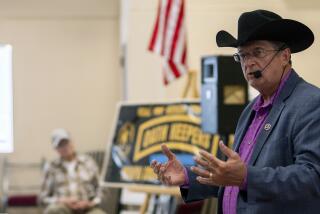U.S. in slow lane on Net
The federal government’s latest annual report on the availability of high-speed Internet service throughout the country contains 19 pages of detailed data -- pie charts, bar graphs, maps and column upon column of numbers and percentages.
Most of them are useless.
The Federal Communications Commission considers any Internet connection faster than 200 kilobits per second to be high speed, even though that’s too slow to effectively watch streaming video and download large files. And if broadband service is available to one home in a ZIP Code, the FCC assumes it to be available to everyone in that area because it lacks any more detailed data.
“Nobody knows how many people in the country don’t have broadband available to them. That just doesn’t exist,” said Jeff Campbell, director of technology and trade policy for network equipment leader Cisco Systems Inc. “We ought to know that.”
As the United States falls in international rankings of broadband availability -- 15th in one leading gauge, compared with fourth in 2001 -- policymakers trying to reverse the slide are missing something essential in the Information Age: good information.
The Government Accountability Office last year warned of a “lack of reliable data” on the deployment of broadband, the fast, always-on connections usually delivered over phone or cable TV lines that allow users to do much more than they can with old-fashioned dial-up service. Rep. Edward J. Markey (D-Mass.), who is chairman of the House committee that oversees Internet policy, said U.S. officials were “flying blind” as they tried to make high-speed access available throughout the country.
Federal and state officials are working on solving the data problem. They warn that getting high-speed Internet access to more Americans is crucial to the nation’s economic growth and the ability of U.S. companies to compete globally.
The FCC has been studying how to improve its annual report.
Now, legislation is moving through Congress that would dramatically upgrade the government’s broadband data.
A bill by Markey that unanimously passed the House this month would require the FCC to collect information on the actual number of broadband subscribers in a ZIP Code, something phone and cable firms have resisted providing, as well as data on price and speeds of service.
The bill also would create a searchable map so consumers could find providers in their area.
“We’re going to have a broadband CT scan of America,” Markey said.
Such detailed information would help determine whether the low number of subscribers in some areas results from a lack of available service or high prices. Phone companies support Markey’s bill, and similar legislation is pending in the Senate.
California and other states are also working on getting better information, and Markey’s bill would authorize $275 million in grants over the next three years for local efforts to improve data collection and get service to people without it.
Kentucky has become a model for launching a public-private partnership called ConnectKentucky to create a detailed state map that shows where broadband is available down to the smallest geographic boundaries: census blocks. The data are one reason broadband availability and use in the state have increased by 50% since 2004, with more than 90% of Kentucky homes now having access to high-speed lines.
California’s Broadband Task Force, created this year by Gov. Arnold Schwarzenegger, has made better data a priority. The group’s final report, due in the next couple of weeks, will contain a comprehensive map that shows the various access speeds in use and a list of communities that have no service.
“We’ve already produced some maps that are so much better than anything the federal government has for California. It’s just day and night,” said Jonathan Taplin, a professor at USC’s Annenberg School for Communication and a task force member. “The data on the federal level is fairly useless.”
The GAO agreed. It found that although 96% of Kentucky households were in ZIP Codes that had access to high-speed Internet service in mid-2005, ConnectKentucky’s data showed that service was available to only 77% of homes in the state.
“If we relied on that inaccurate data, we’d basically be overlooking a couple hundred thousand households,” said Brian Mefford, chief executive of ConnectedNation, the parent company of ConnectKentucky. “Clearly, having accurate data is a key starting point for achieving any policy objective . . . because we have to identify the gaps before we can most effectively decide what policies will ultimately get those gaps filled.”
Although the United States leads the world with 66.2 million broadband subscribers and the number of high-speed lines has been increasing rapidly, the percentage of the population with access hasn’t kept up with that of many other countries, according to the Organization for Economic Cooperation and Development, an association of 30 democratic nations.
The United States ranked 15th in the 2007 ranking, behind major countries such as South Korea, Britain and France, as well as small nations like Iceland and Luxembourg. Although critics point out flaws in the organization’s methodology, nobody disagrees that the United States lacks the best data about its broadband use to help it improve its position.
“By finding out which states and which parts of states are far behind, we will then be able to put in place the policies that can close the digital divide,” Markey said.
--
More to Read
Sign up for Essential California
The most important California stories and recommendations in your inbox every morning.
You may occasionally receive promotional content from the Los Angeles Times.










